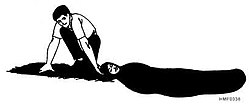m |
|||
| (11 intermediate revisions by 3 users not shown) | |||
| Line 1: | Line 1: | ||
| + | <noinclude><translate><!--T:1--> | ||
| + | </noinclude> | ||
[[Image:Blanket_drag.jpg|thumb|250px|right|Blanket Drag]] | [[Image:Blanket_drag.jpg|thumb|250px|right|Blanket Drag]] | ||
| − | The blanket drag can be used to move a person who, due to the severity of the injury, should not be lifted or carried by one person alone. | + | The blanket drag can be used to move a person who, due to the severity of the injury, should not be lifted or carried by one person alone. Place the casualty in the supine position on a blanket and pull the blanket along the floor. Always pull the casualty headfirst, with the head and shoulders slightly raised so that the head will not bump against the floor. |
<br style="clear:both"> | <br style="clear:both"> | ||
| + | <noinclude></translate></noinclude> | ||
Latest revision as of 19:22, 26 July 2022
The blanket drag can be used to move a person who, due to the severity of the injury, should not be lifted or carried by one person alone. Place the casualty in the supine position on a blanket and pull the blanket along the floor. Always pull the casualty headfirst, with the head and shoulders slightly raised so that the head will not bump against the floor.

